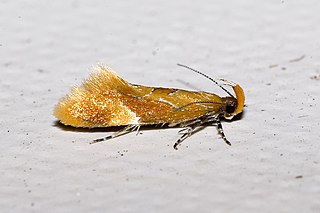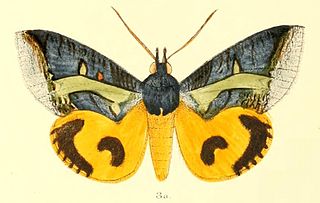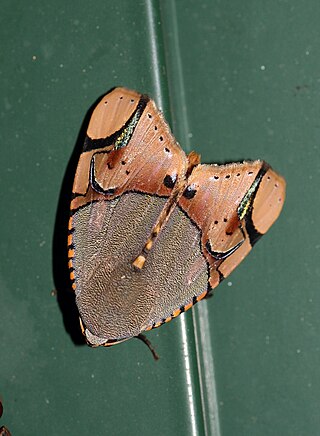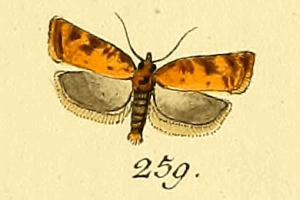
The red underwing is a moth of the family Erebidae. The species was first described by Carl Linnaeus in his 1767 12th edition of Systema Naturae.

The common footman is a moth of the family Erebidae. The species was first described by Johann Leopold Theodor Friedrich Zincken in 1817. It is distributed throughout Europe and east through the Palearctic to Lake Baikal.

The burnet companion moth is a moth of the family Erebidae. It is found in most of the Palearctic realm, from Ireland in the west to Mongolia and Siberia in the east and south to the Mediterranean and North Africa.

The sycamore is a moth of the family Noctuidae. The species was first described by Carl Linnaeus in his 1758 10th edition of Systema Naturae. It is distributed through most of Europe, from central England south to Morocco. To the east it is found from the Near East and Middle East to western Asia.

Nepita is a monotypic moth genus in the subfamily Arctiinae erected by Frederic Moore in 1860. Its only species, Nepita conferta, the footman moth, was first described by Francis Walker in 1854. It is found in India and Sri Lanka.

Lacanobia contigua, the beautiful brocade, is a moth of the family Noctuidae. The species was first described by Michael Denis and Ignaz Schiffermüller in 1775. It is found throughout temperate regions of the Palearctic realm, from Ireland east to Siberia and Japan.

Epicallima formosella is a species of gelechioid moth. It belongs to subfamily Oecophorinae of the concealer moth family (Oecophoridae).

Eudocima homaena is a moth of the family Erebidae first described by Jacob Hübner in 1816. It is found in the Indian subregion, Sri Lanka, Myanmar, Taiwan, the Nicobars, Peninsular Malaysia, Borneo, the Philippines and on Christmas Island. It is a major pest on orange plants.

Jodia croceago, the orange upperwing, is a moth of the family Noctuidae. The species was first described by Michael Denis and Ignaz Schiffermüller in 1775. It is found in southern and central Europe, to the north up to the southern half of England and Wales. According to Warren. W. in Seitz, A. Ed., 1914 also in Algeria, Asia Minor, and Armenia.

Ramadasa pavo is a moth of the family Noctuidae first described by Francis Walker in 1856. It is found in south-east Asia. Including Sumatra, Borneo, Sabah, Sulawesi, Thailand, Sri Lanka, India and China.

Gesonia obeditalis is a species of moth of the family Noctuidae first described by Francis Walker in 1859. It is found from eastern Africa, the Seychelles, the Maldives and the Oriental tropics of India, Myanmar, Sri Lanka east to the Philippines, the Sula Islands and Australia. The adult moth has brown wings with a scalloped dark brown band near the margin. The hindwings are similar in pattern to the forewings but are a paler shade of brown.
Schrankia croceipicta is a species of moth of the family Erebidae. It was first described by George Hampson in 1893. It is found in Sri Lanka and the Seychelles.
Cyclosiella dulcicula is a moth of the family Erebidae first described by Charles Swinhoe in 1890. It is found in southern India, the northeast Indian state of Assam, Sri Lanka and Myanmar.

Epicallima icterinella is a moth of the family Oecophoridae. It is found in Croatia, Bulgaria, Serbia, Greece, as well as on Crete and Cyprus. Outside of Europe, it is found in Asia Minor and Syria.

Acleris aspersana, the ginger button, is a species of moth of the family Tortricidae. It is found in Europe, where it has been recorded from Ireland, Great Britain, France, the Benelux, Germany, Denmark, Austria, Switzerland, Italy, the Czech Republic, Slovakia, Slovenia, Croatia, Hungary, Bulgaria, Romania, Poland, Norway, Sweden, Finland, the Baltic region and Russia. It is also found in the Near East and the eastern Palearctic realm. Their habitat consists of meadows and forest edges.

Sanguinograptis albardana is a species of moth of the family Tortricidae. It is found in the Republic of Congo, the Democratic Republic of Congo, Equatorial Guinea, Guinea and Gambia.
Helcystogramma octophora is a moth in the family Gelechiidae. It was described by Edward Meyrick in 1918. It is found in South Africa.

Notoreas niphocrena is a species of moth in the family Geometridae. It is endemic to New Zealand.

Notoreas simplex is a species of moth in the family Geometridae. It is endemic to New Zealand.

Epicallima is a genus of concealer moths in the family Oecophoridae. The genus was erected by Harrison Gray Dyar Jr. in 1903. There are about seven described species in Epicallima, found primarily in North America and Europe.



















